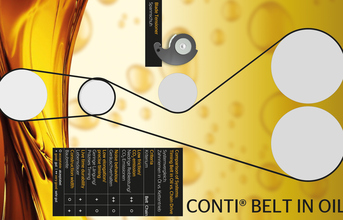
The advantage of the timing belt in oil is that it has a narrower construction than the dry-running version and is even quieter
"Since the start of 2013, the ContiTech Power Transmission Group has been part of the group of series production suppliers for these applications. Timing belts are already in use for oil pump and timing drives in the newer Ford, PSA, and Volkswagen engines," says Ralf Berger, head of Key Account Management and Application Engineering at the ContiTech Power Transmission Group.
What was previously unthinkable is today running along without a hitch in series production. To achieve this, ContiTech has adapted the elastomer, the fabric, and the cord to the new environment.
In addition to polyamide and aramid fabric with a Duralon coating containing Teflon, an ultra-durable rubber compound made from ACN-HNBR (hydrogenated acrylonitrile butadiene rubber), as well as E-glass and K-glass, is also being used for high length stability. Because of these special components, even impurities in the oil cannot harm the belt, whereas simple soot particles in the oil can destroy chains.
The advantage of the timing belt in oil is that it has a narrower construction than the dry-running version and it is even quieter. In the case of a crankshaft pulley with 19 teeth, no noise can be detected, even with the engine operating under full load, because the oil not only reduces friction, it absorbs sound as well.
This is important for the simple reason that the increasingly popular downsized engines generally run less smoothly. Here is where a belt can help minimize vibration and make driving a pleasant experience despite the use of environmentally friendly technology.
Benchmark trials also demonstrate that belts today have at least the same and often even better properties than chain drives with their hydraulic tensioners and plastic guides. This is why developers are no longer concentrating on durability - this has long been a given. In on-road tests, the belts still ran without a hitch even after 300,000 kilometers.
The question today is one of making the belts even narrower - every millimeter counts, because installation space in vehicles is becoming ever tighter. "This is where the belt has another advantage. The engine designer has more flexibility in designing the belt drive than with a chain," says developer Hermann Schulte.
Continued to next page


























